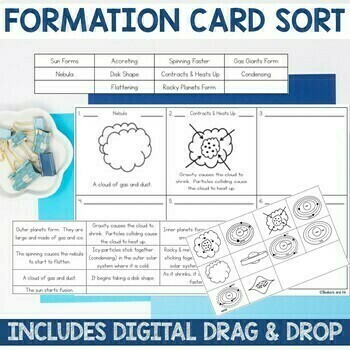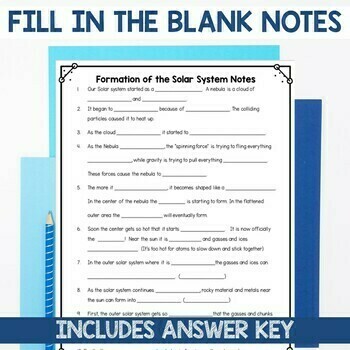
The seven sets of activities and problems in this section of the Year of the Solar System guide call for students to use calculus and modeling to understand how planets are formed. Formation of the Solar System Lab Learning Objectives.

The first version involves using a roll of toilet paper to create the model.
Formation of the solar system activity. Solar System and Planets. The seven sets of activities and problems in this section of the Year of the Solar System guide call for students to use calculus and modeling to understand how planets are formed. Formation of the Solar System.
Birth of Worlds 639KB PDF file. A classroom activity in which students learn about the main steps in the formation of our Solar System by completing a crossword and creating their own comic strip. We know about the planets moons and space rocks that make up our Solar System.
But where did it all come from. Find lessons on Formation of the Solar System for all grades. Free interactive resources and activities for the classroom and home.
The most unusual features of the Solar System are likely attributable to giant impacts. Relatively large satellites of small planets Earth-Moon. Non-equatorial orbit of Moon gross differences in surface compositions.
Retrograde motion of system. All the foregoing constraints are consistent with the general idea introduced in Other Worlds. An Introduction to the Solar System that the solar system formed 45 billion years ago out of a rotating cloud of vapor and dustwhich we call the solar nebula with an initial composition similar to that of the Sun today.
As the solar nebula collapsed under its own gravity material fell toward the center where. Download the Planet Sort worksheet. Look at the photos of the different stages in the formation of a planet.
Order the images from a planets beginning until it is fully formed based on your knowledge and intuition. Dont take more than 5 minutes to try to figure this out. A solar system is made up of a star and all of the objects that orbit itplanets moons asteroids comets and meteoroids.
Most stars host their own planets so there are likely tens of billions of other solar systems in the Milky Way galaxy alone. Solar systems can also have more than one star. Formation of the Solar System Lab Learning Objectives.
Discuss the formation of our solar system. Evaluate the role of gravity in the solar systems formation. Explain how the temperature of the solar system and abundance of elements impacted the formation of planets.
Model how matter clumped together under the force of gravity to form the celestial objects of our Solar System. Formation of the Solar System 1 The Nebular Theory. The theory that our solar system formed from a swirling mass of gas and dust.
Any large cloud of interstellar gas and dust. The Nebular theory was one of the first heliocentric theories for the formation of the solar system. In Nebular Theory a nebula called the solar nebula collapsed in on its own gravity forming a disc.
The idea that the solar system was born from the collapse of a cloud of dust and gas for proposed by Immanuel Kant 1755 and by Pierre Simon Laplace 40 years later. During the first part of the 20th century some proposed that the solar system was the result of a near collision of the Sun with another star. This lab activity includes two possible ways to create scale models of our solar system.
In each activities students will have to do some math to properly scale the distances of the planets from the sun. The first version involves using a roll of toilet paper to create the model. Each sheet of t.
Kitchen Table Model of the Formation of the Solar System On the right you can try making a model of the formation of our solar system using pepper and a bowl of water. Models are representations of events or phenomenon that help us understand that phenomenon. Think of a world globe.
Wow that is a big difference isnt it. The solar system includes the sun and the eight planets that orbit the sun. Mercury Venus Earth Mars Jupiter Saturn Uranus and Neptune.
The story of the formation of solar system starts with the formation the Sun. The scientific theories predicts that within the galaxy there was a nebula. Nebula is the cloud of stellar gas and dust.
It was not violent and didnt show any kind of dynamic events until something happened that caused the nebula to collapse on itself. The radial flux of pebbles toward the star was recently demonstrated to determine the outcome of planetary growth in the inner regions of the protoplanetary disc. Interactive Science Activities Help students understand the solar system including the universe gravity and inertia and the planets using these six science activities and their real-world examples.
Our Solar System and all other star systems form from a collapsing nebula. Often called stellar nurseries nebulae are the birthplace of stars. They are made up of mostly hydrogen but also contain other matter like gases dust ice and rock.
The gravity of the nebula pulls this matter into the centre and the nebula experiences a gravitational collapse. If the compression raises the core temperature. Clouds of diverse chemical matter spun around our Sun coming together to form our Earth and Solar System.